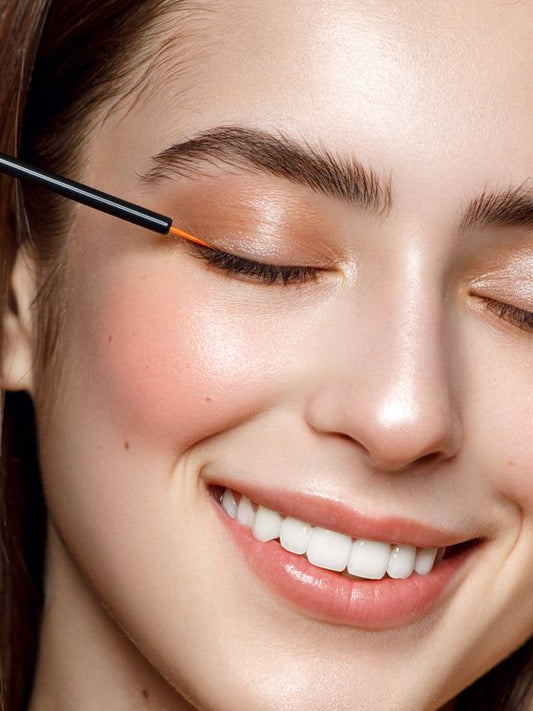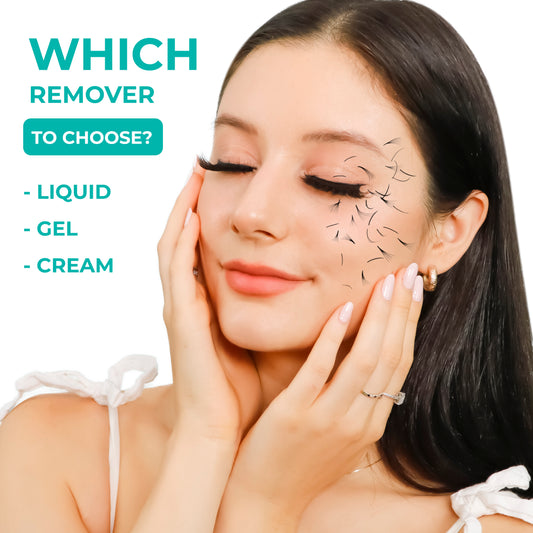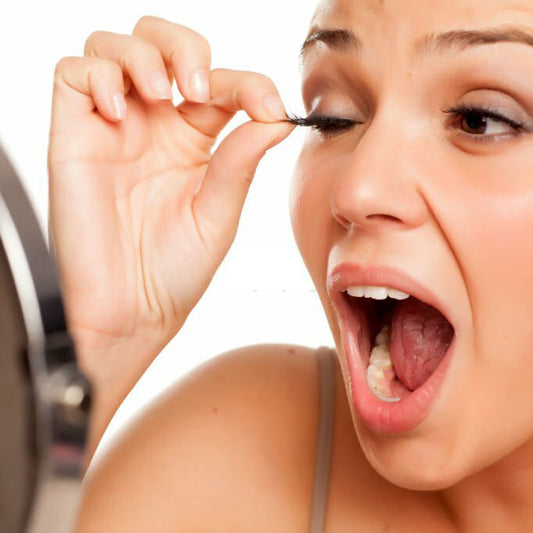10 Tips To Combat Lash Mites In Your False Lashes
Did you know that there are microscopic creatures called lash mites residing on your eyelashes? These tiny creatures, can have a significant impact on our lash health. In this blog post, we will explore everything of eyelash mites, from their life cycle, to the potential problems they can cause when they overgrow.
It's time to uncover the hidden dangers that may be lurking in your false lashes.
What are Lash Mites?
Lash mites are tiny arachnids that make themselves at home on your eyelashes. These worm-like creatures measuring only 0.3 to 0.4 millimeters long, live in the hair follicles and sebaceous glands of humans.
They are on virtually everyone's skin, crawling around and feed on dead skin cells, oils, and other debris found on your skin's surface. Their presence is usually harmless and goes unnoticed.

The Hidden Dangers of Eyelash Mites
Under normal circumstances, lash mites play a beneficial role in maintaining skin healthby consuming dead skin cells and regulate the oil production in the hair follicles. However, when their population becomes excessive, it can lead to lash and skin problems.
Overgrowth of eyelash mites can cause lash loss, itching, redness, and inflammation. In severe cases, it may even contribute to conditions like blepharitis, a common eyelid inflammation, which cause serious discomfort, eye irritation, and potential vision disturbances. Therefore, it is essential to keep lash mite populations in check to maintain lash health.
How to know if you have lash mite overgrowth?
It's important to be aware of the signs that may indicate eyelash mite overgrowth. Common symptoms include itchiness, redness, and irritation of the eyelids. Some individuals may also experience a gritty or burning sensation in their eyes. In more severe cases, eyelash mite overgrowth can lead to eyelash loss or styes.

Lash mite overgrowth is more common in certain populations. Older individuals, those with weakened immune systems, and people with oily skin are more susceptible to experiencing an overgrowth of eyelash mites.
Hidden risks of false lashes
False lashes have become increasingly popular in recent years, with many people using them to enhance their natural lashes and achieve a more dramatic look. However, what many people don't realize is that when false lashes enhance your beauty, they hide the hidden risks of contributing to overgrowth of eyelash mites.
Poor eyelid hygiene feeds mites
Not just elderly or oily skin individual are more likely to have overgrowth eyelash mites. One of the primary factors can contribute to lash mite overgrowth is poor eyelid hygiene, which can be caused by artificial lashes.
These tiny creatures thrive in warm, dark environments, making your false lashes the perfect breeding ground. These beautiful lashes provide a cozy hiding spot for lash mites. The adhesive used to attach the false lashes can also attract eyelash mites, as it can trap dirt, oil, and dead skin cells, providing a food source for the mites.
Heavy weight
Additionally, the weight of the false lashes can put stress on the natural lashes, weakening them and making them more susceptible to mite infestation. Also, if you are a lazy person, failing to cleanse the eyelids regularly can create an ideal environment for mites to thrive.
Improper lifestyle
Furthermore, certain lifestyle habits can also play a role in mite overgrowth. For instance, sleeping with makeup on or using expired eye products can create an environment that is conducive to mite proliferation. Additionally, sharing eye makeup or using unclean makeup brushes can introduce mites to the eyelashes.
Does wearing false lashes grow lash mites?
Scientific studies have shown a correlation between false lash usage and increased mite presence. A study published in the Journal of Cosmetic Dermatology found that individuals who wore false lashes had a higher prevalence of lash mites compared to those who did not use false lashes. The study also noted that the longer the duration of false lash usage, the higher the mite population.
Another study published in the International Journal of Trichology examined the impact of false lashes on eyelash mite infestation. The researchers found that the use of false lashes led to an increase in lash mite density and a higher incidence of eyelash mite-related symptoms, such as itching and inflammation.
While these studies provide valuable insights, it's important to note that individual experiences may vary. Some people may not experience any issues with eyelash mites despite using false lashes, while others may be more prone to mite-related concerns. It's essential to be aware of the potential risks and take appropriate measures to maintain good lash hygiene.
Does wearing eyelash extensions grow lash mites?
Unlike self-applied false lashes, eyelash extensions are professionally applied by a lash technician, reducing the need for personal hygiene practices during the application process. However, to maintain the lash sets for an extended period and prevent lash mites, here are some essential steps you should keep in mind:
1. Keep your lashes clean: Cleanse your lash extensions daily using a gentle, oil-free cleanser. This helps remove any debris, oils, or makeup residue that can attract eyelash mites.

2. Avoid oil-based products: Oil-based makeup, cleansers, and skincare products can contribute to mite growth. Opt for oil-free alternatives to minimize the risk.
3. Use a lash cleanser with tea tree oil: Tea tree oil has natural antimicrobial properties that can help keep eyelash mites in check. Look for a lash cleanser that contains tea tree oil and use it regularly.
LiiLash's Lash Shampoo: Your Daily Cleansing Solution
For effective daily cleansing and prevention of lash mites, we recommend using LiiLash's lash shampoo. This gentle yet powerful formula is specially designed to cleanse lash extensions, removing impurities and keeping them in optimal condition. With three delightful aroma options: strawberry, green tea and basic, you can enjoy a refreshing cleansing experience every day.
4. Be gentle when cleansing: Use a soft brush or a clean spoolie to gently cleanse your lash extensions. Avoid rubbing or pulling on the lashes, as this can cause damage and create an entry point for mites.
5. Avoid excessive moisture: Excessive moisture can create a breeding ground for lash mites. Avoid steam rooms, saunas, and excessive sweating to minimize the risk.
6. Don't overuse mascara: While it's tempting to enhance your lash extensions with mascara, it's best to avoid it. Mascara can attract mites and make it harder to clean your lashes thoroughly.
7. Maintain regular fills: Regularly visit your lash technician for fills to ensure your lash extensions are in good condition. They can also help monitor for any signs of eyelash mite infestation.
8. Practice good overall hygiene: Keep your face and eye area clean, avoid touching your lashes with dirty hands, and change your pillowcase regularly to prevent the transfer of bacteria and mites.
How to protect yourself from lash mites
Follow Hygiene Practices
Don't worry, you don't have to give up your beloved false lashes just yet. Proper hygiene practices are crucial in minimizing mite-related concerns when using false lashes. Here are some tips to minimize the risk of eyelash mites
- Cleanse your eyelids and lashes thoroughly before applying false lashes. Use a gentle cleanser or a specially formulated lash cleanser to remove any dirt, oil, or makeup residue.
- Avoid sharing false lashes with others to prevent the transfer of eyelash mites.
- Replace your false lashes regularly to minimize the buildup of bacteria and mites.
- Consult with a professional lash technician for proper hygiene practices.
- Wash your hands thoroughly before handling your false lashes to prevent transferring bacteria or dirt onto them.
- Avoid sleeping with your false lashes on. Removing them before bed allows your natural lashes to breathe and reduces the risk of mite infestation.
- Opt for high-quality lashes: Choose false lashes made from hypoallergenic materials, such as mink or synthetic fibers, to reduce the likelihood of irritation or allergic reactions.
- Check the adhesive ingredients: Look for lash adhesives that are latex-free and formaldehyde-free. These ingredients can be potential irritants and may increase the risk of mite infestation.
- Consider magnetic lashes: Magnetic lashes eliminate the need for adhesive, reducing the chances of mite-related issues. They are also reusable, making them a more sustainable choice.
Seeking Professional Advice: Personalized Care for Your Lashes
If you're unsure about how to care for your false lashes or suspect a mite infestation, it's always a good idea to seek guidance from dermatologists or lash specialists. They can provide personalized advice and recommend suitable products for your specific needs.
By following these precautions, you can significantly reduce the risk of eyelash mite infestation and keep your lashes looking fabulous. Remember, prevention is key when it comes to maintaining the health and longevity of your lashs
How To Get Rid Of Eyelash Mites?
If you suspect a lash mite infestation or want to take proactive measures to eliminate these pesky organisms, there are several effective methods and products to consider:
- Tea tree oil: Known for its antimicrobial properties, tea tree oil can help kill lash mites. Dilute a few drops of tea tree oil in water and apply it to your lashes using a clean spoolie brush.
- Lash serums: Some lash serums contain ingredients that can help eradicate mites. Look for serums with active ingredients like bimatoprost or isopropyl cloprostenate.
- Prescription treatments: In severe cases, dermatologists may prescribe medicated treatments to eliminate eyelash mites. These treatments typically come in the form of ointments or creams.
Conclusion
Remember, prevention is always better than cure. So remember to follow the cleaning and care tips mentioned earlier. you can significantly reduce the risk of lash mite infestation and enjoy beautiful, healthy lashes. If you suspect a lash mite problem, consult a professional for guidance and explore the available treatment options. With proper care and attention, you can continue to rock your false lashes with confidence!
YOU MAY ALSO LIKE
Lash Extension Aftercare: Everything You Need To Know







